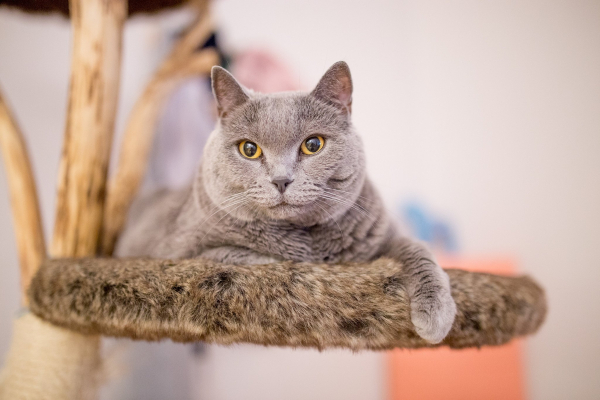Vše o kočičí březosti
V červenci je ten pravý čas k “zadělání” na podzimní koťata. Je fajn si tedy připomenout, co všechno kočičí březost přináší, kdy a jak jí předejít a proč.
Did you know that the domestic cat which is now kept as a pet all over the world, is probably a domesticated form of the wild cat, specifically of its subspecies the African wildcat, European wildcat and Asiatic wildcat?


Did you know that the domestic cat which is now kept as a pet all over the world, is probably a domesticated form of the wild cat, specifically of its subspecies the African wildcat, European wildcat and Asiatic wildcat?
Cat has accompanied humans already for thousands of years. The oldest existing records of existence of domesticated cats come from the time of 8,000 years ago from Turkey. However, its domestication started already with first stable human settlements, approximately 12,000 years ago. Humans have spread the domestic cat around the whole world where it’s still kept in many households.
Egypt
The greatest glory of the cat occurred in Egypt where it became a significant part of the human life around the year of 3,000 BC. The ancient Egyptians worshipped the cat as a deity. According to them, it had the power to protect humans from evil. That’s why killing of a cat was punished by death and body of a dead cat was embalmed. The most sacred was the black cat who protected the Egyptian temples, it even had its own goddess Bastet. Although export of cats from Egypt was prohibited, thanks to traders, these protectors of harvest still spread into the whole Mediterranean.
China
In China, the breeding of cats started around 1,000 BC. Cat wasn’t missing in any temple and it was under the protection of the Buddhist religion, it was allegedly supposed to protect from poverty. However, a superstition also comes from China, that black cat bears bad luck.
India
In India, the domestication of the cat occurred at the break of the era. Cat was worshipped here in the form of the goddess of fertility Shashthi. Nevertheless, the Indians believed, that fallen-out cat hair can ritually foul a man.
Japan
Cat got to Japan only at the beginning of the Middle Ages from China. Its task here was to guard the cocoons of the silkworm and to protect old manuscripts in temples from rats. The Japanese also believed, that a cat who will live up to a hundred years will turn into a witch.
Greece
First evidence in Europe comes precisely from Greece, from the 5th century BC, when the cat started to appear in various depictions on ceramics, specifically on vases. Here, the cat was associated with the goddesses Aphrodite and Artemis.
Rome
Cat got to Rome at the same time as to India, at the break of the era, and it became a decoration of palaces. But soon, it spread also to the lower classes. Although the Romans overtook the cult of the goddess Artemis from the Greeks (they called it Diana themselves), they had a rather pragmatic approach towards cats as the hunters of rodents.
England and Scotland
The cat was brought to England only by Roman legionnaires on their military campaigns. As in the rest of Europe, the cat was protected by law in England and its killing was strictly penalised.
Although the cat was respected almost everywhere, the view of the people changed soon afterwards and their persecution began. You’ll read more in the next article.


V červenci je ten pravý čas k “zadělání” na podzimní koťata. Je fajn si tedy připomenout, co všechno kočičí březost přináší, kdy a jak jí předejít a proč.


Teploty venku napovídají, že sezóna vodáků klepe na dveře. Plno lidí vyráží se svojí rodinou a dětmi za vodáckým dobrodružstvím. Výjimkou nejsou ani vodáci, kteří s sebou berou své čtyřnohé miláčky. Co udělat pro to, aby váš výlet s pejskem proběhl bez...


V létě se život většiny z nás přesouvá na zahradu, ať už u domu, nebo chalupy. Tuto možnost chceme samozřejmě dopřát i našim přátelům hlodavcům a pouhé vynesení klece ven není ono. Jak tedy na pohodlný a bezpečný výběh?


Všichni jsme se na léto jistě těšili. Celé dny můžeme trávit venku, vyrážet na dlouhé hodiny do přírody nebo se koupat v jezeře. Jak si ale léto užít na pIné pecky a neřešit návštěvy u veterináře?


Chodí váš kočičí chlupáč ven? Nebaví vás neustálé mňoukání a škrábání na dveře nebo věčně otevřená okna? Pak je načase pořídit mu dvířka pro kočky.


Nároky jednotlivých psů na výživu se liší. Podle životního stádia, tělesné kondice, životního stylu a velikosti. Aspektů je spousta a při výběru krmiva je potřeba je všechny zohlednit.


Kočku může rýma potrápit o dost hůř než nás. U nich totiž jde o poměrně vážné a hlavně velice nakažlivé virové onemocnění. Kočičí rýmou se totiž označuje souhrn onemocnění, mezi jejichž příznaky patří právě rýma.


Jaké elementy hrají ve výživě kočky důležitou roli, proč je chlupáči potřebují a v jakém poměru by je měli přijímat? To je alchymie, která se skrývá za přípravou kvalitního krmiva pro kočky.


Toto plemeno bychom mohli charakterizovat jako velkou osobnost v malém těle. Ačkoli jméno těchto malých, původem belgických, psíků znamená malý ovčák, ovce nikdy nepásli.


Vlci bývají ještě dnes hojně diskutovaným tématem a část obyvatel se stále na jejich přítomnost v našich lesích dívá negativně. Důvodem je fakt, že si na jejich výskyt během několika desítek let, kdy tu nežili, odvykli. Přitom mají tyto šelmy...


Suchá kůže dokáže potrápit i naše zvířecí parťáky. Než ji začneme léčit, je potřeba přijít na příčinu, což nemusí být úplně jednoduchý úkol. Jak se lupy u psů projevují, jaké mají příčiny a jak se jich šetrně zbavit?


Nepřítel je možná slabé slovo, vhodnější by zřejmě bylo říct rovnou zabiják. Tento vzácný druh klíštěte se pomalu šíří Českem a psy dokáže nakazit nemocí připomínající malárii.